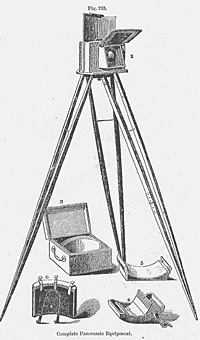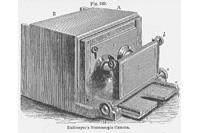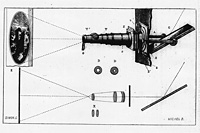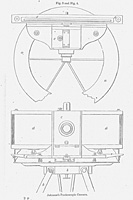Camera
 This is an image of a tripod camera with a panorama lens, exhibited at the London International Exposition of 1862. The world's first photograph took eight hours for exposure. However, around the time of the international exposition, the exposure time was shortened, nurturing the assumption that a camera would be operated outside, such as at travel destinations.
This is an image of a tripod camera with a panorama lens, exhibited at the London International Exposition of 1862. The world's first photograph took eight hours for exposure. However, around the time of the international exposition, the exposure time was shortened, nurturing the assumption that a camera would be operated outside, such as at travel destinations.
J. N. Niépce of France was the first person to fix an image through a lens, using the chemical action. In 1826, he took a photograph of the scenery outside of a window. It is said that the exposure time was approximately eight hours. He used a type of asphalt as a photosensitive material in order to utilize its characteristic of hardening when exposed to light.
L. J. M. Daguerre was working on joint research with Niépce. After the death of Niépce, in 1837, Daguerre perfected the daguerreotype, a method of producing images on a silver-coated copper plate. The development of images reduced the exposure time to dozens of minutes. However, this method did not work for moving objects. Also, only a single photograph with mirror-reversed images could be obtained.
Subsequently, W. H. F. Talbot of England invented a negative/positive process called calotype, enabling the production of many photographs. Also, the French government purchased the patent for the daguerreotype and made it available to the public, promoting the improvement of photosensitive materials and lenses across Europe, and reducing the exposure time to just a few minutes. This led to a boom of having portrait photographs taken among the middle class. In 1839, a portable daguerreotype bellows camera and tripod were invented. As of 1844, a panoramic photograph depicting a 150 degree view was already taken. The photograph was taken on a curved plate, as shown in the above picture, by shaking the direction of a lens with a short focal length.
Since calotype used paper as a photographic negative, it did not provide very clear images. In 1851, F. S. Archer of England introduced a wet plate process, which featured the use of a wet glass plate coated with a liquid photosensitive material called collodion, enabling the production of clear photographs at low prices. This led to photo shooting for newspapers or other purposes around the world. Photographs were taken at battlefields and renowned sightseeing destinations, such as the Pyramids. Also, photos were taken to depict the construction progress of Crystal Palace at the first London International Exposition.
The camera of the above image was the one used around that time.
In 1871, R. L. Maddox invented a dry plate process featuring a dry glass plate coated with gelatin. Since such a dry plate could be preserved for a long time, it began to be sold as consumer goods, making photo shooting more common. In 1888, G. Eastman of the United States, the founder of Kodak Co., developed a lightweight, flexible celluloid roll film as a replacement for a heavy-weight, fragile glass plate. This resulted in the development of today's camera using which even amateur photographers can take pictures just by pressing the shutter. At the Chicago International Exposition of 1893, Kodak possessed the exclusive right of photo shooting and issued permission for 100 dollars per day.
- References:
Nakagawa, Kuniaki.: Eizo no kigen: Me no shisaku: 'Shashinkyo' (Kamera obusukyura) ga hatashita yakuwari (Bijutsu shuppansha, 1997) <KC752-G47>
Suzuki, Hachiro.: Hatsumei no rekishi kamera (Hatsumei kyokai, 1980) <KC752-E16>




